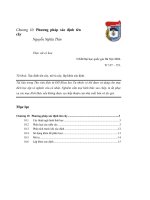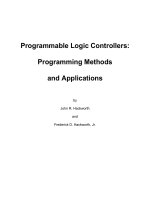Tài liệu Phần mềm xác định radio P1 docx
Bạn đang xem bản rút gọn của tài liệu. Xem và tải ngay bản đầy đủ của tài liệu tại đây (334.86 KB, 21 trang )
Part I
Perspective
The BellSouth RFI was perhaps the catalyst that brought software radio into the commercial
arena. In this part the author of that seminal document presents his current perspective, 6
years on, reviewing terminology and potential, and exploring the continuing need today for
further technology advances
Software Defined Radio
Edited by Walter Tuttlebee
Copyright q 2002 John Wiley & Sons, Ltd
ISBNs: 0-470-84318-7 (Hardback); 0-470-84600-3 (Electronic)
1
Software Based Radio
Stephen M. Blust
Cingular Wireless
This chapter offers an introduction to software based radio (SBR), discusses some top-level
global drivers for (SBR) designs, and postulates potential evolutionary implications for soft-
ware radio in one key market space (commercial wireless). It provides a vision for the
potential impact of software radio, supplying a context for the more detailed technology
presented in subsequent chapters of this book.
SBR, also known as software defined radio (SDR) or just software radio (SR), is a tech-
nological innovation that is coming of age for wireless communications of many types. There
is no one single agreed definition of SBR/SDR/SR terminology, in part because there are
several different perspectives for the technology. In a broad sense, as will be described and
illustrated later, the technology involves more than just ‘radio’ in the classic sense of the word
‘radio’. It also involves more than just ‘software’ in the usual usage of that word.
In this chapter, suggested definitions are presented along with examples of the use of the
terminology. Throughout this chapter, the term ‘software based radio’, as defined, is used as
an overarching term that comprises SDR, SR, and adaptive-intelligent SR (AI-SR).
1.1 A Multidimensional Model Sets the Stage
The multidimensional aspects and different perspectives of SBR are illustrated in Figure 1.1.
Starting at the bottom of the figure, the radio implementers’ plane is what many people think
about when using the terms ‘SR’ and ‘SDR’. In this plane SDR is simply an implementation
technique. At the radio level, SBR can be viewed simply as an efficient technique for the
construction of wireless devices. The use of SBR technology is predicted to replace many of
the traditional methods of implementing transmitters and receivers while offering a wide
range of advantages including adaptability, reconfigurability, and multifunctionality encom-
passing modes of operation, radio frequency bands, air interfaces, and waveforms. This is the
most fundamental perspective and the one that is encountered most frequently in the litera-
ture. This perspective is described in more detail in Section 1.3.1.
Ultimately, the full benefits of SBR can be achieved only by modifications to the network
level of a wireless communications system. That is why the term ‘SBR’ refers to more than
Software Defined Radio
Edited by Walter Tuttlebee
Copyright q 2002 John Wiley & Sons, Ltd
ISBNs: 0-470-84318-7 (Hardback); 0-470-84600-3 (Electronic)
the receiver-transmitter pair of a wireless system. It involves the overall wireless system;
hence the network operator plane. This is discussed in more detail in Section 1.3.2.
The service provider plane and the user applications plane round out the scope of SBR.
Service providers see several advantages to the SBR technology, especially when viewed
from a system level perspective. It allows the service provider a mechanism for service
differentiation, and it provides a cost-effective means for easily upgrading the network
infrastructure as technology evolves. In other words, upgrades to the infrastructure could
be achieved through software downloads to the network and handset components instead of
costly hardware swap outs of network components and handsets.
Finally, the user’s application level depicted provides a user’s perspective of the advan-
tages of SBR. One could conceive that included in this plane would be the ability for an
implementation of an SBR to have excess capacity in the hardware/software combination
required to perform the radio functions at any given moment. This capability could be utilized
to execute other user applications: for example a music player/codec for downloaded digital
music. Thus the potential exists for reducing costs and increasing functionality by not adding
into the device a separate dedicated processing system just for applications that might reside
within it. The close internal coupling may be useful for users receiving services and capabil-
ities on demand from a number of sources; these are shown by the vertical lines cutting across
the planes in Figure 1.1.
The primary focus of the material presented in this chapter is the radio and network
operator plane. The service provider and user planes are introduced in order to provide a
Software Defined Radio: Enabling Technologies4
Figure 1.1 The Multidimensional perspectives of software based radio. Reproduced by permission of
Cingular Wireless.
complete picture of the multidimensional aspects. These planes will be the subjects of
future work as the lower planes are developed and implemented. In many respects the
lower planes (radio and network) can be viewed as the critical enabling foundation for
the potentials and benefits of SBR to be extended beyond the edges of the traditional
‘wireless cloud’. Ultimately, the entire concept can be likened to the internet model but
applied from the wireless device core operating system up through the applications
themselves.
1.2 What is Software Based Radio?
The terms ‘SDR’, ‘SR’, and ‘AI-SR’,asdefined, are utilized throughout this chapter to denote
specific implementation stages of SBR. The term ‘SBR’ is introduced as a generic term for
this broad collection of technology and concepts. Usage of this term means that the informa-
tion will be generally applicable across all manifestations of the technology. SBR includes
both software signals to process the radio signal and software control of the radio parameters
as illustrated in Section 1.3.4.
1.2.1 Software Defined Radio and Software Radio
There are many understandings of what is considered a ‘software based radio’. An SBR can
be generically defined as a radio that uses software techniques on digitized radio signals. The
fundamental intent is to shift from employing a traditional hardware-focused, application-
specific approach to radio implementation to using a software application to perform the radio
tasks on a computing platform,
For clarification, and to understand the evolution stages possible in SBR as a function
of advances in the underlying core technologies, we have chosen two commonly accepted
terms: ‘SDR’ and ‘SR’. As technology progresses, an SDR can move to an almost total
SR where the digitization is at (or near to) the antenna and all of the processing is
performed by software residing in high-speed digital signal processing functionality.
Hence, the SDR will occur in the near term, migrating to the SR in the longer term,
subject to the progression of core technologies. The need for such progression will be a
function of the application. For example, a base station application may require and/or be
able by virtue of technology advances and design latitude to move to a software radio, but
a handset or portable terminal, because of numerous constraints, may not need or be able
to progress beyond an SDR.
1.2.1.1 Definition of the Software Defined Radio
An SDR is defined as a radio in which the receive digitization is performed at some stage
downstream from the antenna, typically after wideband filtering, low noise amplification, and
down conversion to a lower frequency in subsequent stages – with a reverse process occurring
for the transmit digitization. Digital signal processing in flexible and reconfigurable func-
tional blocks defines the characteristics of the radio.
Software Based Radio 5
1.2.1.2 Definition of the Software Radio
As technology progresses, an SDR can move to an almost total SR, where the digitization is at
(or very near to) the antenna and all of the processing required for the radio is performed by
software residing in high-speed digital signal processing elements.
A simple example of how these two definitions are related to each other is illustrated in
Figures 1.2–1.5. It is evident from inspection of these, in light of the definitions chosen, that
there is a key transition stage in the metamorphosis of SDR to SR. This metamorphosis is a
function of core technology advances balanced against the full scope of design criteria and
constraints applied to the wireless product. Core technology in this instance includes, as a
minimum, analog to digital to analog conversion capabilities, digital signal processing
advances, algorithms, memory advances, including similar attributes of the fundamental build-
ing blocks required for the digitization and manipulation of radio signals in the digital space
and any requisite translation in frequency of the analog environment [1]. Design criteria and
constraints include such factors as cost, complexity, performance, form factor, size, weight,
power consumption, and so on. Additional analysis of these stages is provided in Section 1.3.1.
In the simplified example shown of a commercial wireless terminal device (i.e. a cellular or
personal communications service (PCS) handset) there is a need to accommodate multiple
radio technology interface types and frequency bands into the terminal. In a traditional
implementation approach each unique radio interface or band combination would be
constructed around a dedicated set of specific application or function integrated circuits.
Essentially, the capabilities are hard coded and fixed at the time of design or manufacture.
To increase the number of supported modes or bands, additional units of function are added
into the terminal. These functional blocks would operate in a matrix arrangement of radio
interfaces and frequency bands to provide a set of a priori defined capabilities.
Initial application of SBR results in the SDR as shown in Figure 1.3. At the onset the
principal advantage is substitution of technology in the implementation. Subsequent imple-
mentations build on this base and engender wider ranging flexibility which can span the
gamut from simple updates of radio functionality to complete over-the-air downloads of new
radio interfaces. Sharing of processing capabilities by radio functions and applications riding
the radio transport is a cost-effective leveraging of SBR radio capabilities that is a tractable
step beyond the limitations inherent in the application-specific and unchangeable function
blocks available in devices today.
Software Defined Radio: Enabling Technologies6
Figure 1.2 SDR evolution – stage 1: cellular /PCS generic single mode, single band handset. This
figure is representative of ANY single mode (i.e. AMPS, TDMA, CDMA, GSM, PHS, etc.) and single
frequency band (i.e. 850, 900, 1800, 1900, etc.) handset. This is considered to be the traditional design
product implementation. Reproduced by permission of Cingular Wireless.
Software Based Radio 7
Figure 1.4 SDR Evolution – stage 3: A/D, D/A,and signal processing chips currently have the
capacity to perform this IF and baseband processing. Reproduced by permission of Cingular Wireless.
Figure 1.3 SDR Evolution – stage 2: quadruple-band (800, 900,1800, and 1900 MHz), quadruple-
mode (AMPS, TDMA, GSM, CDMA), traditional-design, multiband, multimode handset. Reproduced
by permission of Cingular Wireless.
In the above discussion and throughout this chapter the terms ‘digital signal processors’
(DSPs) and the like are used in a broad sense; therefore DSPs include field programmable
gate arrays (FPGAs), reconfigurable computing (RC), etc.
1.2.2 Adaptive Intelligent Software Radio and Other Definitions
For the sake of completeness and clarification, some addition terms and concepts should be
considered in any discussion of SBR. They are reviewed in this section.
1.2.2.1 Definition of Adaptive Intelligent Software Radio
An AI-SR is one which is capable of adapting to its operational environment thereby achiev-
ing enhanced performance and/or spectral efficiency.
The basic concept underlying such terminology is the ability of the radio to adapt to its
environment by automatically adapting (i.e. without human intervention) its operational
mode to achieve enhanced performance and efficiency. This requires the use of artificial
intelligence, significant computational power to process adaptive algorithms in real time,
and real-time data from a variety of sources including the mobile network infrastructure,
radio frequency (RF) bands available, air interface protocols, user needs, applications, mini-
mum performance requirements (which might be subscriber dependent as well as application
dependent), the propagation environment, and the capabilities of the SDR platform. Thus, the
AI-SR radio is an extension of the SDR and SR concepts as defined above. As a simple
example of this extension, the radio might adapt in real time to the propagation environment
by using a more robust waveform developed dynamically as the propagation environment
rapidly deteriorates. Although at first glance this might appear relatively easy to implement,
Software Defined Radio: Enabling Technologies8
Figure 1.5 SDR Evolution – stage 4: future product as technology evolves in A/D capabilities, etc.
Reproduced by permission of Cingular Wireless.
in reality it is very complex because of the need to interact with the mobile network infra-
structure and the need for the radio to process all of the inputs described above.
1.2.2.2 Definition of Digital Radio, Multiband, and Multimode
Digital radio is a radio in which the information is digitized at some point between the
antenna and the input/output devices. Digital radio does not necessarily mean that the
radio is an SDR. A radio may be digital, but if the signal processing that takes place after
the A/D conversion is performed by special purpose, application-specific integrated
circuits (ASICs) it is not an SDR. Multiband is the capability of handsets or base stations
to operate in multiple frequency bands of the spectrum. Multimode refers to the capability
of a handset or base station to operate in multiple modes (e.g. multiple air interface
standards, multiple modulation techniques, or multiple access methods). Multiband/multi-
mode capabilities may be implemented using a variety of hardware and/or software
techniques, including SDR.
It should be recognized that SBR is applicable to many differing marketplaces for wireless.
A common distinction that has been made is to consider three major application universes:
†
commercial wireless (e.g. cellular, personal communications services (PCS), land mobile,
etc.)
†
civil government (e.g. public safety, local, state, and national communications, etc.)
†
military
Each of these major markets has a differing set of criteria (e.g. cost, weight, size, perfor-
mance, features, etc.) that directly impacts the application and definition of SBR as applied
to each of these domains. This must be taken into account when understanding the evolution
and influence of SBR. There is, however, significant overlap in the applicability of SBR
across these market domains and this is a strong driver for the development, and adoption,
of SBR.
In this chapter, the focus is on SBR as principally applied to the commercial wireless
domain. Increasingly, reconfigurability, flexibility, multiband, and multimode characteris-
tics are required in all types of radio based communications systems including commercial
wireless services, military communications, and civil government services. Many of these
systems are evolving into their next generation counterparts. As a result, these systems
face the problems associated with a deployed embedded base and the need to preserve
continuity across both the old and new systems, often over a transition interval that may
span many years. There is an increased expectation of usability by those who deploy
systems and by the end users of such systems. Manufacturers of systems face related
concerns in providing product for these marketplaces. Consequently, broad interoperability
among diverse systems using many frequency bands, often on a global basis, forms a
baseline requirement now and into the future. In the longer term, the ability to evolve an
embedded base of deployed wireless systems, both infrastructure and terminal devices, to
accommodate new capabilities on a dynamic basis will become an additional key design
factor. Solutions to dynamic reconfigurability include both a versatile hardware and soft-
ware environment and the ability to provide updated, enhanced, or replacement capabil-
ities via a download mechanism.
Software Based Radio 9









